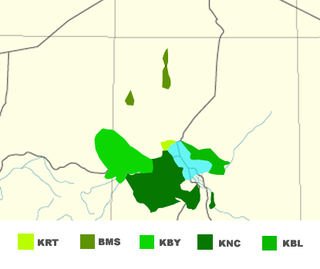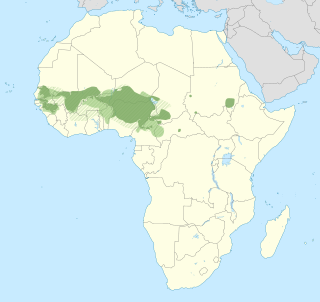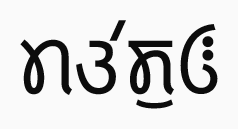Related Research Articles

In phonology, an allophone is one of multiple possible spoken sounds – or phones – or signs used to pronounce a single phoneme in a particular language. For example, in English, the voiceless plosive and the aspirated form are allophones for the phoneme, while these two are considered to be different phonemes in some languages such as Thai. Similarly, in Spanish, and are allophones for the phoneme, while these two are considered to be different phonemes in English.

Kanuri is a dialect continuum spoken in Nigeria, Niger, Chad and Cameroon, as well as by small minorities in southern Libya and by a diaspora in Sudan.

The Mandinka language, or Mandingo, is a Mande language spoken by the Mandinka people of Guinea, northern Guinea-Bissau, the Casamance region of Senegal, and in The Gambia where it is one of the principal languages.

Buryat or Buriat, known in foreign sources as the Bargu-Buryat dialect of Mongolian, and in pre-1956 Soviet sources as Buryat-Mongolian, is a variety of the Mongolic languages spoken by the Buryats and Bargas that is classified either as a language or major dialect group of Mongolian.
Berta proper, a.k.a. Gebeto, is spoken by the Berta in Sudan and Ethiopia. As of 2006 Berta had approximately 180,000 speakers in Sudan.

Fula, also known as Fulani or Fulah, is a Senegambian language spoken by around 36 million people as a set of various dialects in a continuum that stretches across some 18 countries in West and Central Africa. Along with other related languages such as Serer and Wolof, it belongs to the Atlantic geographic group within Niger–Congo, and more specifically to the Senegambian branch. Unlike most Niger-Congo languages, Fula does not have tones.

Shipibo is a Panoan language spoken in Peru and Brazil by approximately 26,000 speakers. Shipibo is a recognized indigenous language of Peru.
Air Tamajeq (Tayiṛt) is a variety of Tamasheq, one of the Tuareg languages. It is spoken by the Tuareg people inhabiting the Aïr Mountains of the Agadez Region in Niger.
Guéré (Gere), also called Wè (Wee), is a Kru language spoken by over 300,000 people in the Dix-Huit Montagnes and Moyen-Cavally regions of Ivory Coast.

The Tarahumara language is a Mexican Indigenous language of the Uto-Aztecan language family spoken by around 70,000 Tarahumara (Rarámuri/Ralámuli) people in the state of Chihuahua, according to a 2002 census conducted by the government of Mexico.
Koromfé is a Gur language spoken in a U-shaped area around the town of Djibo, in the north of Burkina Faso and southeastern Mali, bordering Dogon Country.
Unlike many languages, Icelandic has only very minor dialectal differences in sounds. The language has both monophthongs and diphthongs, and many consonants can be voiced or unvoiced.
Southern Oromo, or Borana, is a variety of Oromo spoken in southern Ethiopia and northern Kenya by the Borana people. Günther Schlee also notes that it is the native language of a number of related peoples, such as the Sakuye.
The Kaingang language is a Southern Jê language spoken by the Kaingang people of southern Brazil. The Kaingang nation has about 30,000 people, and about 60–65% speak the language. Most also speak Portuguese.
Nyimang, also known as Ama, is an East Sudanic language spoken in the Nuba Mountains of Sudan by the Nyimang people who are a sub-group of the Nuba people.
Gwari is a Nupoid language spoken by the Gbagyi people, which make up over a million people in Nigeria. There are two principal varieties, Gbari and Gbagyi, which have some difficulty in communication; sociolinguistically they are distinct languages.

Mahasu Pahari is a Western Pahari language spoken in Himachal Pradesh. It is also known as Mahasui or Mahasuvi. The speaking population is about 1,000,000 (2002). It is more commonly spoken in the Himachal Pradesh, Shimla (Simla) and Solan districts. It is to be known that Shimla and Solan were parts of the old Mahasu district. Himachal Pradesh State on 1 September, 1972 reorganised the districts dissolving Mahasu district. The Solan district was carved out of Solan and Arki tehsils of the then Mahasu district and tehsils of Kandaghat and Nalagarh of the then Shimla District of Punjab.
Avava (Navava), also known as Katbol, Tembimbe-Katbol, or Bangsa’ is an Oceanic language of central Malekula, Vanuatu. It has nasalized fricatives and a bilabial trill.
Ot Danum is a Barito language of the central Borneo, Indonesia, spoken by the Ot Danum people. Dialects include Cihie and Dohoi.
Medumba phonology is the way in which the Medumba language is pronounced. It deals with phonetics, phonotactics and their variation across different dialects of Medumba.
References
- ↑ Bena at Ethnologue (26th ed., 2023)

Kidugala at Ethnologue (26th ed., 2023)
Lupembe at Ethnologue (26th ed., 2023)
Benemanga at Ethnologue (26th ed., 2023)
- ↑ Jouni Filip Maho, 2009. New Updated Guthrie List Online
- ↑ Morrison (2011)
- Morrison, Michelle Elizabeth (2011). A Reference Grammar of Bena (Doctor of Philosophy thesis). Rice University. hdl: 1911/70359 .